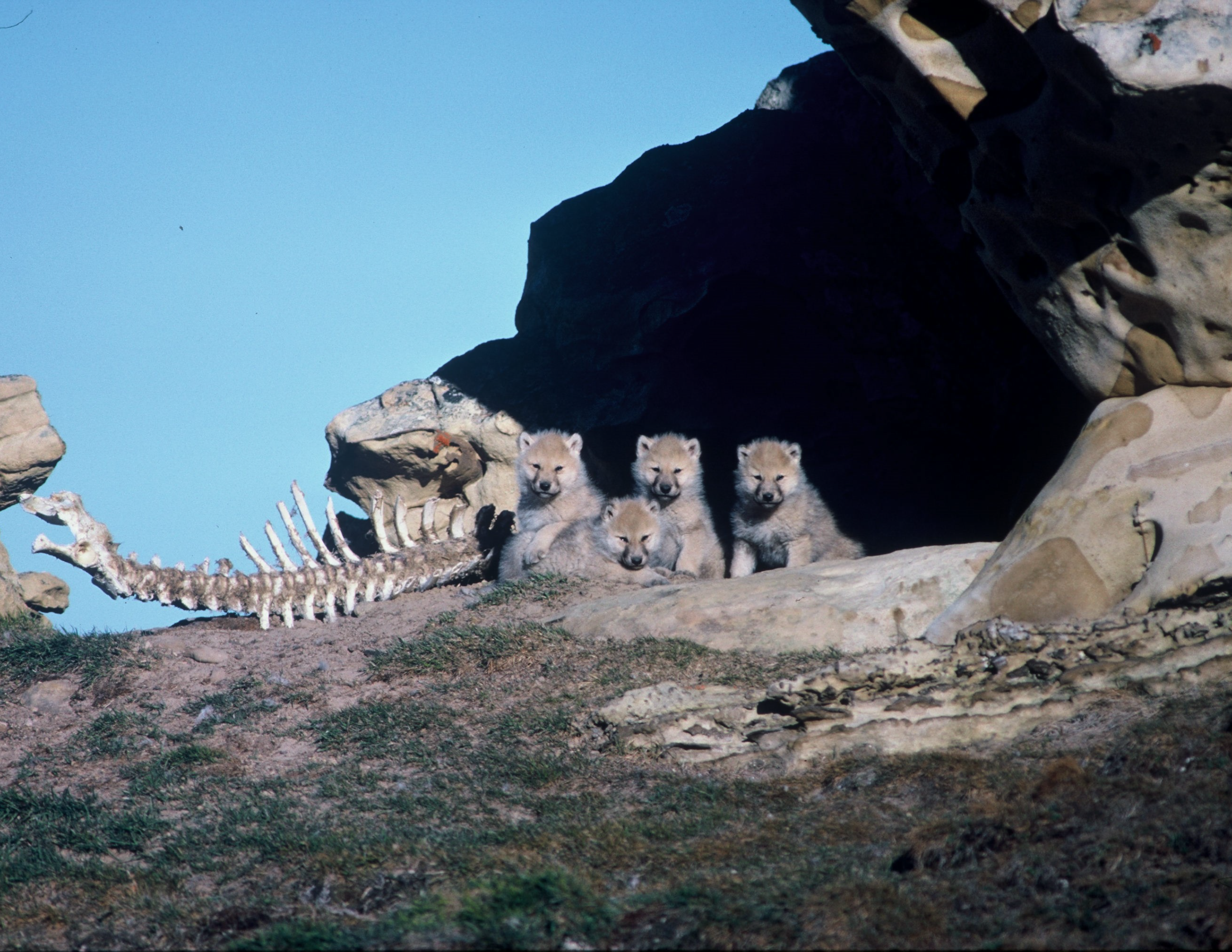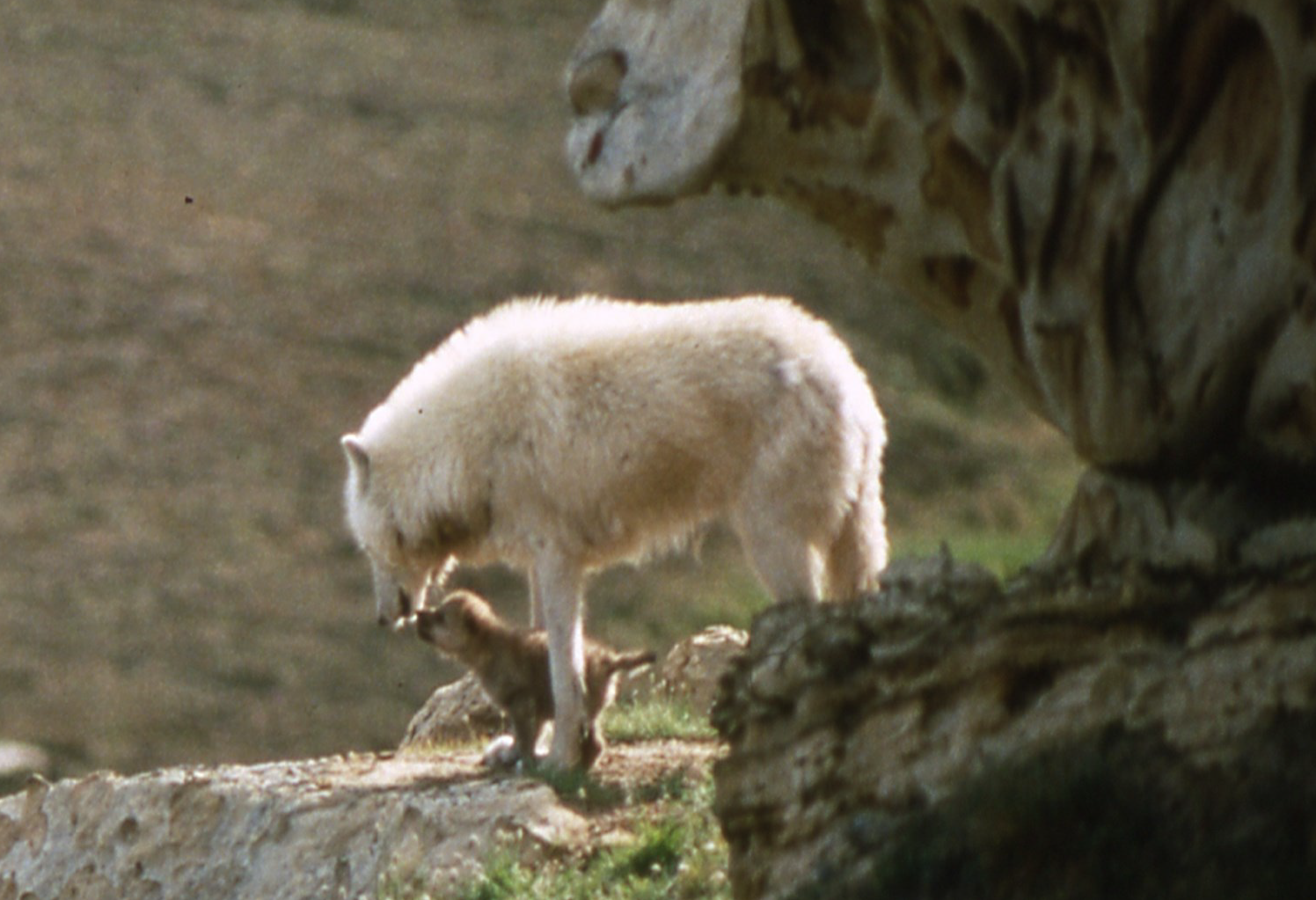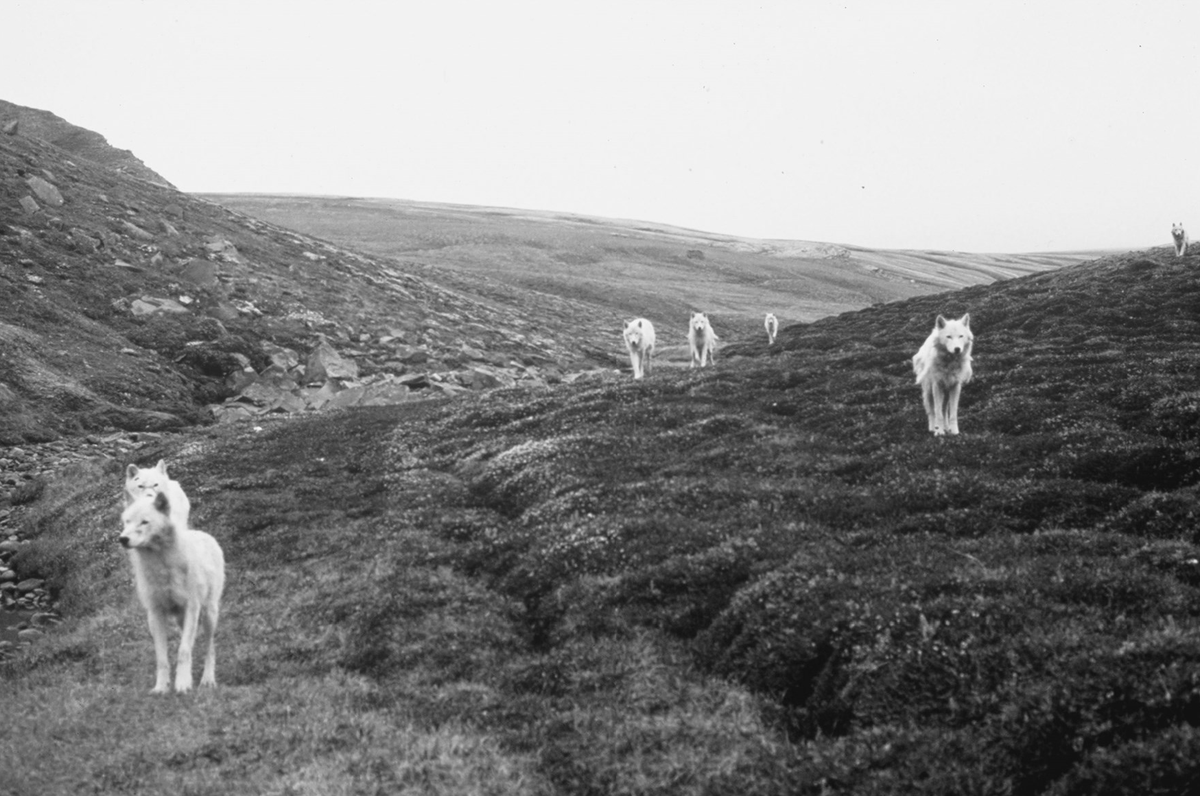This piece is part of a new Sequencer series about wolves. Read the companion essay for more.
Biologist L. David Mech has studied wolves in North America for nearly 70 years. During that span as a university professor and research scientist with the U.S. Fish & Wildlife Service and U.S. Geological Survey, Mech has lived through the descent and rise of the country’s wolf populations.
But many of his most notable contributions came outside the country — on a Canadian island in the High Arctic, known as Ellesmere.
Mech became the foremost biologist to study the wolves of Ellesmere—a population that has lived in isolation from humans and hunters for generations. Ellesmere’s wolves were surprisingly tame. Mech and his colleagues, including Morgan Anderson and H. Dean Cluff, recently wrote in a book about all they’ve learned from summers spent on the island since 1986.
The following is an excerpt from the second chapter of The Ellesmere Wolves titled “The Den.”
"The Den"
And now I had found it.
It was an amazing and life-changing moment. Greeted by seven barking and howling wolves, elated that I had finally located an active den yet afraid my disturbance might cause the adults to move the pups, I quickly gathered my thoughts. I couldn’t help anticipating all I might learn by observing the pack here, but I figured I should probably leave right away to minimize my disturbance even though I hadn’t seen any pups yet. Still, I knew the little bundles of fur had to be in the hollow, so better to head out now and return later to allow the adults to settle down.
I had parked my ATV several meters up the hill while I strolled down the hillside, but I had carried down a pail of meat scraps from the weather station. I immediately tossed the wolves some offerings and started uphill toward my ATV. The wolves instantly scarfed up the scraps and busied themselves, noses down, searching around for more—except for one scruffy, probable one-year-old wolf (yearling), that is, that followed me up the hill. I threw it another scrap, mounted my ATV, and sped away.
“Scruffy” followed for quite a distance as I bounced over the tundra hummocks away from the den with my mind racing about all the potential I imagined now that I knew the den’s location. Only a week of my summer stint here had passed, so I would have many more weeks to observe the island’s wolves. At that time, I had no inkling about what kinds of observations I might eventually make or that those summer weeks I still had left here would preface so many more summers.
I would wait a day and then sneak up to where I could view the den from a different direction on foot with binoculars. Crawling up to the edge of an opposite hill, I would observe as long as I could to get an idea about how many pups the pack had and how far away I would need to stay for the wolves to tolerate me.
The chance to observe wolves while on their own terrain and watch them interact with pups came just at the right time in my career. I had captured hundreds of wolves in modified-steel foot traps, weighed the animals, taken their blood, radio-collared them, and followed and observed them from aircraft. It was now new and refreshing for me to actually be out on the ground with wolves and sharing their space while they did their thing. I had not done that since my early summer days on Isle Royale decades before. Even then, however, I only rarely ever saw a wolf, and the few times I did, I merely caught a glimpse of it.
Ellesmere brought a whole new and revolutionary experience. Already, each day had yielded different observations and portended new possibilities. How close would I be able to get to these wolves and to their den and pups? Would the adults allow me to follow them like I had been doing with Mom? From what distance? Only a few other biologists had observed wolves around a den, but in doing so, they had learned things about wolves that I did not know, the kind of information one absorbs from interacting with one’s own pets—a real familiarity not afforded by a trapped wolf or from wolves observed far below an aircraft.

This was a time when other wolf biologists were helping fill the many information gaps about wolves in various other areas, often using techniques I had pioneered or taught them. Thus, researchers conducting wolf projects in several parts of both North America and Eurasia were live-trapping or darting wolves, radio-collaring them, locating them from the air, and putting location points on maps showing their travels and territorial spacing.
Collectively we had established that a wolf pack is a family of parents and offspring and that most maturing offspring disperse from the pack to find a mate and start a pack of their own. Packs raise pups in dens during spring and summer but become nomadic around large territories during the rest of the year. Parent wolves defend their territories via howling and by scent-marking with urine as well as by directly attacking trespassing wolves. Adults travel far and wide to find prey vulnerable enough to kill with the least risk, but they succeed during only a small proportion of the time, and then mainly by killing very young, old, or debilitated individuals.
However, most of the real breakthroughs in wolf biology had still not been made. The radio collars being used were standard types developed in 1963; it was not until several years after I first landed on Ellesmere that GPS radio-tracking collars were invented. Almost another decade would pass before wolves would be reintroduced into Yellowstone. And the field of molecular genetics was just emerging and had not yet been applied to wolves. Nor had I yet started my study in Denali National Park, Alaska. Even the wolf literature was pretty limited, with my 1970 book still the standard reference work.
In short, the world of wolf research was ready for a new approach, or rather the resurrection of an old approach applied to a new research situation: direct naturalistic observations recorded with pen and paper. Only Adolph Murie (1944), who had observed wolves around a den in Mount McKinley National Park, had really published much about his naturalistic findings. Two other biologists had written theses and a dissertation based at least partly on watching wolves around dens, but almost nothing in the way of peer-reviewed scientific literature had resulted from them.
In that respect, the research situation that I now found myself in had much to offer in the way of unique characteristics. Not only were the subjects of study, if not necessarily tame, then certainly far more tolerant of humans than wolves anywhere else in the world, but they also lived at the northern extreme of the worldwide wolf distribution. In fact, the closest area where wolves had been studied at that time was at least 1,250 miles (2,000 kilometers) away. On top of all that, only one or two people had ever reported on wolf interactions with muskoxen, their main prey on Ellesmere, and no one had studied wolf relations with arctic hares.
This situation was ripe for study.
And I seemed poised to cash in on it. Or at least that is what the situation so far had seemed to promise. During April, I had been able to travel along with the wolf pack on my snowmobile. On the present trip, I was able to follow Mom on my three-wheeler for long distances to the den without her running away from me. Around the den, the pack, while upset at my intrusion, had accepted my meager food offerings, and one had even followed me closely on my ATV for long distances. Now I had several weeks to test the situation, and at the very least I knew I could watch the wolves from a distance through a spotting scope or binoculars.
Ellesmere is wide open, with the nearest tree many hundreds of kilometers away. Sure, there are rocky ridges, boulder fields, hills, and canyons. And the weather is cold and windy. However, layers of clothing could solve the latter challenge, and I already had all that from my April visit. In short, the situation was excellent for long-range viewing. Nevertheless, the closer I could get to the wolves to watch, the better.
Thus, the day after I found the wolves’ den, I approached the area from a hill across the valley from the den and crept to a crest about 200 meters opposite. On a sponge-rubber mattress and in full arctic garb, I gradually inched forward until the full valley in front of the den came into view. There, the whole pack lay spread out sleeping before me. Right away I counted the pups—“one, two, three, four, five, six little beige bundles,” I wrote later (Mech 1987, 567)—and I judged them to be about five weeks old. I was ecstatic. Seven adults and six pups! And the best news was that the wolves had not abandoned the den despite my rude intrusion the day before.
Now, in plain view of the pack but motionless and less conspicuous, my presence would constitute a second test of their tolerance. For hours I peered at the pack through binoculars and snapped photos through my telephoto lens. In due course, the wolves started to arise, and soon the whole pack came alive in a glorious game of chase. Eventually, however, the wolves began to notice me, and for the next hour or so, various individuals including Mom and the pups approached me cautiously, with some adults coming within several meters behind me.
Without arising, I tossed my newfound companions some meat scraps, and that seemed to mollify them. What an experience! The wolves were riled up: they sometimes barked or howled, and they seemed cautious but very alert and excited. What was this strange, fat lump with weird odors protruding from the tundra not far from their den?
I had no reason to fear these creatures because when I first started studying wolves, I had even been able to chase as many as 15 of them away from a kill they had just made (Mech 1966), and just the day before, when I had found this pack’s den, the whole pack had left me alone.
Suddenly my furry hat blew off, and the wolves chased and grabbed it. But the whole pack appeared quite discombobulated, and I wished I could have got out of there without further exposing myself and leave the wolves alone. Some adults circled around behind me, and to my great chagrin, Mom led her pups away from the den. Thinking I had really messed things up, I decided the best thing I could do was leave and let everything die down. Maybe the pack would return to the den. I stood up, picked up my mattress, and strode straight away, with several wolves escorting me while I threw them scraps. Glancing back, however, I did notice that a couple of adults were starting to head with the pups back toward the den.
I was now in a quandary. I was so thrilled and excited to be interacting close-up with a pack of wild wolves on their own grounds, but also I was trying to figure out just how concerned the wolves were about me. They had not run off but rather seemed more bewildered than anything else. Still, the female leading the pups away from the den was disheartening. It was critical to my plans that the pack remain at the den. Thus, should I leave the area entirely again and return a day or two later just to ensure they not abandon the den? Or should I continue to experiment, but more cautiously this time? After all, they now knew that I, an upright human being, was there, yet they seemed pretty tolerant and did return to the den.
I decided it was worthwhile to hang around a bit longer and further size things up. I waited several minutes and then headed slowly back to the crest of the hill. The whole pack had settled back down around the den again, so I settled down on my pad and watched for several more hours. It was an amazing time for me. Here I was finally just watching wild wolves around their den. Even better, I was doing so thousands of miles from civilization.

Twice more, most of the adults ventured up and checked me out, with one approaching to within a few meters. Even Mom and the pups ascended the slope toward me. But then they started heading more or less away from the den. Still, when the rest of the pack joined the little caravan, everyone headed back to the den, where all lay down and slept. I found it hard to believe, but it seemed like, despite all the disturbance I had wrought in the wolves’ most sacred area, the creatures were now calm and relaxed while I lay in plain sight only a few hundred meters away. I continued to observe.
Eventually, a few adults arose, stretched, and touched noses; then five of them started to head up the hill toward me. As they approached, they looked serious as though intent on some mission. Were they going to check me out again? Or were they just going hunting? It was getting late in the day, about the time wolves often start out on a hunt. Whatever their intent, there was nothing I could do but just lie there and see what happened. I lay as still as I could as the whole pack came up to within a few meters. And then they simply bypassed me and continued on their way. They were heading out on a hunt.
I was elated. I clearly had passed the inspection of these five adults, and I grew increasingly confident that during the next several weeks I would be able to observe and study them as I had hoped. But what about Mom and the pups? They were the wolves I most wanted to be able to study. How close would they let me get without spooking? I had lots of questions to get answers to. How often do the pups nurse? When do they start depending on solid food? Who all feeds them? Is there a babysitter, or does Mom remain with them all the time?
Adolph Murie (1944, 28), a US National Park Service biologist, did a study that had hinted at answers to some of these questions but was strictly anecdotal, with no quantification. On a more sober note, there was also Murie’s characterization of watching wolves around the den: “Many hours were spent watching wolves at the den and yet when I undertake to write about it there does not seem to be a great deal to relate, certainly not an amount commensurate with time spent observing these animals.”
As I continued lying on my mattress on the crest of the windy hill for hours watching the den and pondering these questions, Mom and a yearling that had stayed with the pups approached me five times in the next few hours. They were still antsy, yet each time they returned to the pups. Had I passed their test too?
When I first heard of Ellesmere Island, in the late 1960s, while writing my 1970 book, I knew nothing about the place except that it was up near the North Pole. But I did know that ornithologist David Parmelee, when studying ptarmigan there, had caught a couple of wolf pups, and while he carried them back to his tent, their white, arctic wolf mother followed at his heels and acted tame. The idea of white wolves intrigued me. I had used a Parmelee photo of one of them in the book and always wanted to see one.
Although possibly seeing a white wolf was my main motivation, I also became intrigued with various other aspects of the island. To fulfill my responsibility, I would have to learn a great deal about this tenth-largest island in the world, its geology, topography, weather, human outposts, and history as well as about its vegetation, wolves and other wildlife. A budget enough to visit Ellesmere a few times for several weeks and explore it by helicopter would help me do it. How much of that time I would decide to devote to wolves would be up to me.


